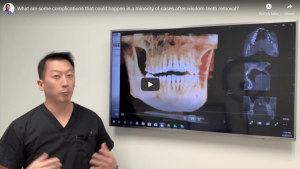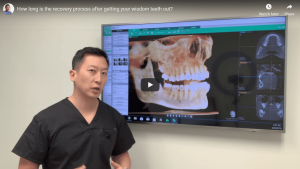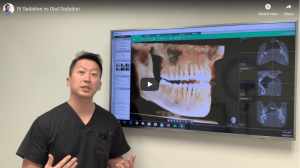Wisdom Teeth Anesthesia
IV Versus Oral Sedation
A commonly asked question by many of our patients regarding the wisdom teeth removal procedure is whether or not they will be sedated for their procedure. During the procedure, we have to numb the patient a number of times to ensure that they will not feel any pain. In addition, the drilling or the noise from the drilling can be disconcerting to many patients. Therefore, in order to give patients’ the best experience, we highly recommend that they undergo sedation.
Oral Sedation Wisdom Teeth
There are many types of sedation available to patients. Oral sedation is commonly offered by practitioners for wisdom teeth removal procedures. Most of these providers use a medication called Halcion for oral sedation and administer several pills to initiate that sedation. Oral sedation typically takes about 45 minutes to kick in. It is a great option for patients who are really fearful of needles.
However, there are some issues with oral sedation. One of the issues with it is that everybody has a different tolerance to medications. We have seen patients who respond very well to oral sedation – they feel great and are relaxed, are very sedated, and they do not remember anything after the sedation wears off. On the other hand, we have seen patients who have a high tolerance for the medication and despite administering a higher dosage, the medication has limited or no effect. As such, they remember everything about the procedure. Thus, oral sedation is a great option for some people, such as the elderly or those fearful of needles. However, it is not the ideal option because it does not allow for titration to effect. For a patient who is in their teen years or 20s, or even 30s, oral sedation is not optimal due to each individual’s tolerance level.
IV Sedation Wisdom Teeth
The second sedation option is IV conscious sedation. The beautiful thing about IV sedation is that it fixes the problem mentioned above, where we can do something called titration to effect. When IV conscious sedation is utilized, medication is administered through the IV line. This type of sedation takes effect within 20-30 seconds. Although everybody has different levels of tolerance, we can find that perfectly sedated level by slowly administering additional medication through the IV. In addition, IV conscious sedation is a very safe form of sedation. In the rare case that a patient is over-sedated, reversal medication can be administered through the IV and will take effect almost immediately to bring the patient out of sedation and in a fully awake and alert state. In summary, IV sedation is a form of sedation that can provide patients with a much safer, more predictable, and more satisfying experience where they can get to an ideal level of sedation. And in the event of any sort of emergency, reversal medications are always on hand to be administered to quickly pull the patient out of sedation. With oral sedation taking 45 minutes to take effect and the unpredictable patient response, it is not the ideal solution. In addition, safety-wise, oral sedation is not able to provide some of the solutions that IV anesthesia can provide.
Oral and IV Sedation Together?
Despite the limitations of oral sedation, one instance that oral sedation is very useful is in the event that the patient is extremely terrified of needles and cannot tolerate IV sedation. In this case, we would administer a dosage of Halcion to initiate the sedation. Once the patient is relaxed and partially sedated, they do not mind when an IV line is started. We can then safely take over with IV anesthesia at that point. Although this is not common, we have seen some patients request to be sedated with Halcion before starting IV sedation. This is a great example of when oral sedation can be more favorably used.




